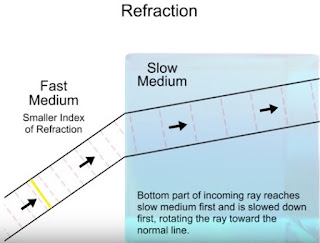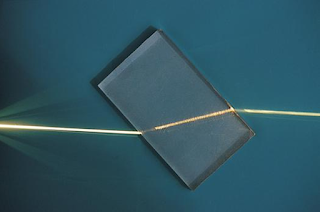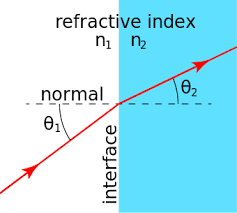This blog focuses on industrial, inline process refractometers and their use in industrial applications. Refractometry is used to measure the refractive index of a substance in order to determine its composition or purity. Posts include information on theory, construction, installation, new products and new markets.
Electron Machine Corporation | Umatilla, FL | PHONE: 352-669-3101 | ElectronMachine.com
Showing posts with label Refraction. Show all posts
Showing posts with label Refraction. Show all posts
What is Refraction?
 |
| Diagram 1 |
For glass, its reduced to 200,000 kilometers per second, and for water the speed is 225,000 kilometers per second.
If the light enters into a medium perpendicular to the surface, it passes straight through but at a slower speed. However if the light beam arrives at the medium surface at an angle, not only will it speed be reduced, but it will bend due to a process called refraction.
To better visualize this phenomenon let's look at Diagram 1. As a beam of light reaches the surface of a medium the lower portion enters first and is slow down. However, the upper portion is still traveling at the speed of light until it arrives at the surface and enters.
This speed difference at the top and bottom aspects of the light path causes it to pivot, bending toward what is referred to as the normal. This is an imaginary line drawn perpendicularly to the surface of the material.
Transparent materials have what is called a refractive index. This is the speed at which light travels in a medium compared to like traveling in a vacuum.
For example, typical glass has a refractive index of 1.33. This is calculated by dividing the speed of light in a vacuum (300,000 km/s) by the speed of light in glass (225,000 km/s).
The refractive index of air is 1.0003. Anytime a light beam travels from a medium with a low index of refraction, like air, to a medium with a higher index of refraction, like glass, the beam of light will bend toward the normal.
Likewise when the beam of light exits a highly refractive medium into a medium with the low index of refraction, the process is reversed.
The bottom portion of the beam of light exits first, and resumes at the speed of light, with the top portion still at the speed determined by the medium. This causes the beam to pivot away from the normal line.
Refractometry: A Basic Understanding and Common Uses
 |
| A ray of light being refracted in a plastic block (Courtesy of Wikipedia) |
 |
| Refraction of a light ray (courtesy of Wikipedia) |
Other common examples of industrial refractometry uses are measuring the salinity of water to determine drinkability; figuring beverages’ ratios of sugar content versus other sweeteners or water; setting eye-glass prescriptions; understanding the hydrocarbon content of motor fuels; totaling plasma protein in blood samples; and quantifying the concentration of maple syrup. Regarding fuels, refractometry scrutinizes the possible output of energy and conductivity, and for drug-testing purposes, refractometry measures the specific gravity, or the density, of human urine. Regarding food, refractometry has the ability to measure the glucose in fruit during the fermentation process. Because of this, those in food services know when fruit is at peak ripeness and, in turn, also understand the most advantageous point in the fruit’s “lifetime” to put it on the market.
The determination of the substance composition of the product examples listed above all speak to the purpose of quality control and the upholding of standardized guidelines; consumers rely on manufacturers not only to produce these products but also to produce these products consistently and identically every single time. Therefore, the success of commercialism, etc. is dependent on maintaining the standards for the composition of substances, i.e. industrial refractometry.
Equipment manufacturers have developed numerous refractometer configurations tailored to specific use and application. Each has a set of features making it the advantageous choice for its intended application.
Subscribe to:
Posts (Atom)